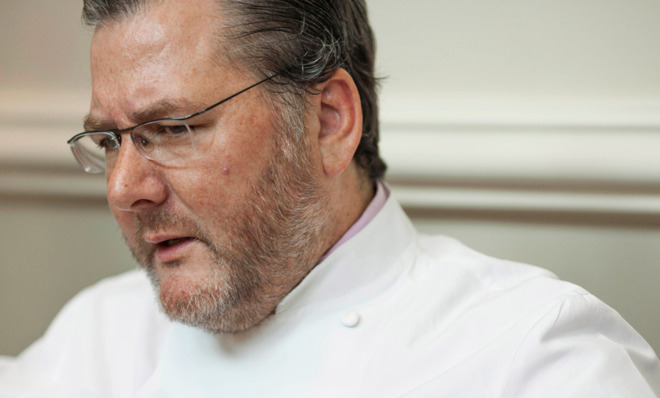5 ways celebrity chef Charlie Trotter changed restaurants in America
An American culinary icon dies at 54

Charlie Trotter's name might not be as recognizable to American gourmands as Mario Batali or Anthony Bourdain. But make no mistake: Trotter, who died on Tuesday in his Chicago home, paved the way for those guys, not to mention nearly every celebrity chef who came after him.
He was reportedly found unconscious at his Lincoln Park home on Tuesday morning, and later pronounced dead at Northwestern Memorial Hospital. He was 54. Despite his relative youth, he had been one of America's most respected chefs since 1987, when he opened his eponymous, Michelin-starred restaurant on Chicago's Armitage Avenue.
Known as a difficult, demanding boss in the kitchen, Trotter closed his flagship restaurant in 2012, and never reached the heights of fame that some of his admirers did. Still, he changed the face of American restaurants in ways many epicureans might not realize.
The Week
Escape your echo chamber. Get the facts behind the news, plus analysis from multiple perspectives.

Sign up for The Week's Free Newsletters
From our morning news briefing to a weekly Good News Newsletter, get the best of The Week delivered directly to your inbox.
From our morning news briefing to a weekly Good News Newsletter, get the best of The Week delivered directly to your inbox.
Tasting menus
Diners in major cities probably take tasting menus for granted. The idea of a set menu of six or eight courses, determined by the chef, is de rigueur in high-end restaurants these days. But it wasn't always like that, as Corby Kummer explained in Vanity Fair earlier this year:
When Trotter began, chefs were just breaking out of their backstage supporting roles and putting themselves on display — often literally, in open kitchens. He helped unleash a generation of chefs no longer willing to take orders. The entire experience they will consent to offer is meant to display the virtuosity not of cooks but of culinary artists. A diner’s pleasure is secondary; subjugation to the will of the creative genius comes first, followed, eventually, by stultified stupefaction. [Vanity Fair]
Like the Japanese omakase menu, the contemporary American tasting menu has become a way for modern chefs to showcase the entirety of their skills and present their food artfully. Trotter began doing it in 1989 — long before many American diners even knew what a tasting menu was.
Putting Chicago on the map
A free daily email with the biggest news stories of the day – and the best features from TheWeek.com
Aside from Thomas Keller's French Laundry, Alinea might be the most celebrated restaurant in the United States. It's famous chef, Grant Achatz, actually worked for Trotter before striking out on his own.
That Alinea exists in Chicago probably has a lot to do with Trotter making the city a dining destination on par with (or even superior to) New York, San Francisco, and Los Angeles. Today, the city boasts a number of famous chefs and restaurateurs, including Rick Bayless (Frontera Grill, XOCO), Paul Kahan (Blackbird, Publican, Avec), and, of course, Achatz, whose Next just might be the hottest restaurant in the country.
Seasonal dining
The term "farm-to-table" is so ubiquitous today that it's almost meaningless. That wasn't the case in 1987. Back then Trotter, along with Alice Waters in Berkeley, Calif., was one of the first American chefs to source "fine, fresh, often-unusual ingredients from small purveyors locally," wrote the Tribune, giving birth to the modern locavore movement.
Giving veggies their due
The idea that a big spender would walk into a Michelin-starred restaurant and order an all-vegetable meal wasn't normal in the '80s and '90s. While many Americans still associate meatless menus with health-food joints, expensive, vegetable-based tasting menus are actually pretty common in today's fine-dining establishments. Trotter was one of the first to do it, serving up meals like the following:
A plate arrives bearing what looks like a cross section of slab bacon, but it’s really a terrine of three separate beet purées — red, golden and chioggia — that have been set in a mold and then sauced with another purée, of horseradish and roasted parsnips: A root-crop tour of the five taste sensations. A porridge of amaranth is enlivened with green cardamom, toasted pistachios and a slice of raw persimmon. [New York Times]
He also wrote one of the seminal veggie cookbooks, Charlie Trotter's Vegetables, which many haute chefs still cherish today.
The celebrity cookbook
Famous chefs had released cookbooks before Charlie Trotter's opened. But the Chicago chef's self-titled 1994 book, "with its glorious full-page color photos of beautiful, complicated, exotic-sounding dishes…was one of the first to function as a coffee-table art book," wrote the Chicago Tribune's Mark Caro in a profile last year.
Now, gorgeously designed books from the world's top restaurants, such as Copenhagen's Noma, are sought after as much for their aesthetic value as for their complicated recipes. Practical, no-frills cookbooks still have their place, of course. But it was Trotter that made cookbooks into collectibles.
Keith Wagstaff is a staff writer at TheWeek.com covering politics and current events. He has previously written for such publications as TIME, Details, VICE, and the Village Voice.
-
 5 criminally underrated cartoons about Pete Hegseth’s war crime
5 criminally underrated cartoons about Pete Hegseth’s war crimeCartoon Artists take on USS Hegseth, rats leaving the sinking ship, and more
-
 Can Mike Johnson keep his job?
Can Mike Johnson keep his job?Today's Big Question GOP women come after the House leader
-
 A postapocalyptic trip to Sin City, a peek inside Taylor Swift’s “Eras” tour, and an explicit hockey romance in December TV
A postapocalyptic trip to Sin City, a peek inside Taylor Swift’s “Eras” tour, and an explicit hockey romance in December TVthe week recommends This month’s new television releases include ‘Fallout,’ ‘Taylor Swift: The End Of An Era’ and ‘Heated Rivalry’